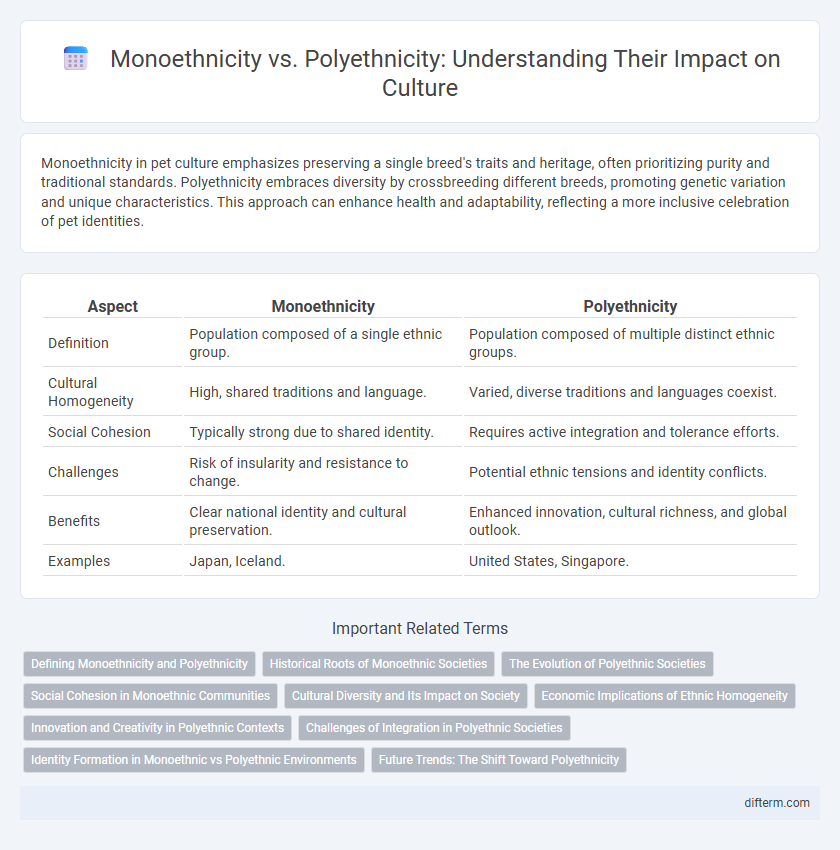Monoethnicity in pet culture emphasizes preserving a single breed's traits and heritage, often prioritizing purity and traditional standards. Polyethnicity embraces diversity by crossbreeding different breeds, promoting genetic variation and unique characteristics. This approach can enhance health and adaptability, reflecting a more inclusive celebration of pet identities.
Table of Comparison
| Aspect | Monoethnicity | Polyethnicity |
|---|---|---|
| Definition | Population composed of a single ethnic group. | Population composed of multiple distinct ethnic groups. |
| Cultural Homogeneity | High, shared traditions and language. | Varied, diverse traditions and languages coexist. |
| Social Cohesion | Typically strong due to shared identity. | Requires active integration and tolerance efforts. |
| Challenges | Risk of insularity and resistance to change. | Potential ethnic tensions and identity conflicts. |
| Benefits | Clear national identity and cultural preservation. | Enhanced innovation, cultural richness, and global outlook. |
| Examples | Japan, Iceland. | United States, Singapore. |
Defining Monoethnicity and Polyethnicity
Monoethnicity refers to a population or society predominantly composed of individuals sharing a single ethnic identity, characterized by uniform cultural practices, language, and heritage. Polyethnicity involves the coexistence of multiple ethnic groups within a society, each maintaining distinct cultural traditions, languages, and social norms. Understanding the dynamics of monoethnic and polyethnic societies is essential for analyzing cultural integration, identity formation, and social cohesion.
Historical Roots of Monoethnic Societies
Monoethnic societies often originate from long-standing historical processes of cultural homogenization and territorial consolidation where a single ethnic group establishes dominance. These societies typically emerge from ancient kingdoms or nation-states that prioritized linguistic, religious, and cultural uniformity to strengthen social cohesion and political stability. Historical examples include Japan's Yamato state and Korea's Joseon dynasty, which fostered monoethnic identities through centralized governance and restrictive immigration policies.
The Evolution of Polyethnic Societies
Polyethnic societies have evolved through centuries of migration, trade, and cultural exchange, fostering diverse identities within shared spaces. This dynamic intermingling enhances social adaptability and innovation by blending languages, traditions, and beliefs. Unlike monoethnic communities, polyethnic societies exhibit complex social networks that promote tolerance and multicultural coexistence.
Social Cohesion in Monoethnic Communities
Monoethnic communities often exhibit strong social cohesion due to shared language, cultural practices, and historical experiences that foster trust and collective identity. The homogeneity in cultural norms reduces social conflicts and facilitates smoother communication and cooperation among members. However, this cohesion can sometimes limit exposure to diverse perspectives, impacting adaptability in multicultural environments.
Cultural Diversity and Its Impact on Society
Polyethnicity fosters cultural diversity by promoting the coexistence of multiple ethnic groups within a society, leading to enriched traditions, languages, and perspectives. This diversity enhances social creativity, economic innovation, and cross-cultural understanding, which are crucial for global interconnectedness. In contrast, monoethnic societies may experience cultural homogeneity that can preserve traditions but often lack the dynamic adaptability seen in more diverse communities.
Economic Implications of Ethnic Homogeneity
Ethnic homogeneity often correlates with streamlined economic policies and lower internal conflict, which can enhance national productivity and attract foreign investment. However, monoethnic societies may face limited innovation and reduced market diversity due to a narrower range of perspectives and skills. Conversely, polyethnic economies benefit from diverse talent pools that drive creativity and global trade opportunities, though they may encounter challenges in social cohesion and equitable resource distribution.
Innovation and Creativity in Polyethnic Contexts
Polyethnic societies foster innovation and creativity by blending diverse cultural perspectives, leading to unique problem-solving approaches and novel ideas. The interaction of multiple ethnic backgrounds cultivates a rich environment where cross-cultural collaboration sparks interdisciplinary advancements. Research indicates that organizations and communities embracing polyethnicity experience higher rates of creative output and adaptive innovation compared to monoethnic settings.
Challenges of Integration in Polyethnic Societies
Polyethnic societies often face challenges in integration due to language barriers, cultural misunderstandings, and conflicting social norms among diverse ethnic groups. These challenges can lead to social fragmentation, reduced social cohesion, and difficulties in creating inclusive public policies that address the needs of all communities. Effective integration requires comprehensive multicultural education, inclusive governance, and community engagement to foster mutual respect and social harmony.
Identity Formation in Monoethnic vs Polyethnic Environments
Identity formation in monoethnic environments centers on shared cultural norms, language, and traditions that reinforce a unified sense of belonging and social cohesion. In contrast, polyethnic environments encourage hybrid identities shaped by the interaction of diverse cultural backgrounds, fostering adaptability and multicultural awareness. Research indicates that individuals in polyethnic contexts often develop complex, fluid identities, while those in monoethnic settings exhibit stronger in-group solidarity and cultural preservation.
Future Trends: The Shift Toward Polyethnicity
Emerging demographic patterns indicate a significant rise in polyethnicity driven by globalization, migration, and intermarriage, reshaping cultural identities worldwide. Future societal frameworks are expected to emphasize multicultural coexistence and hybrid identities, fostering inclusivity and social cohesion. Technological advancements in communication further accelerate this shift by enabling cross-cultural exchanges and diminishing monoethnic isolation.
monoethnicity vs polyethnicity Infographic

 difterm.com
difterm.com